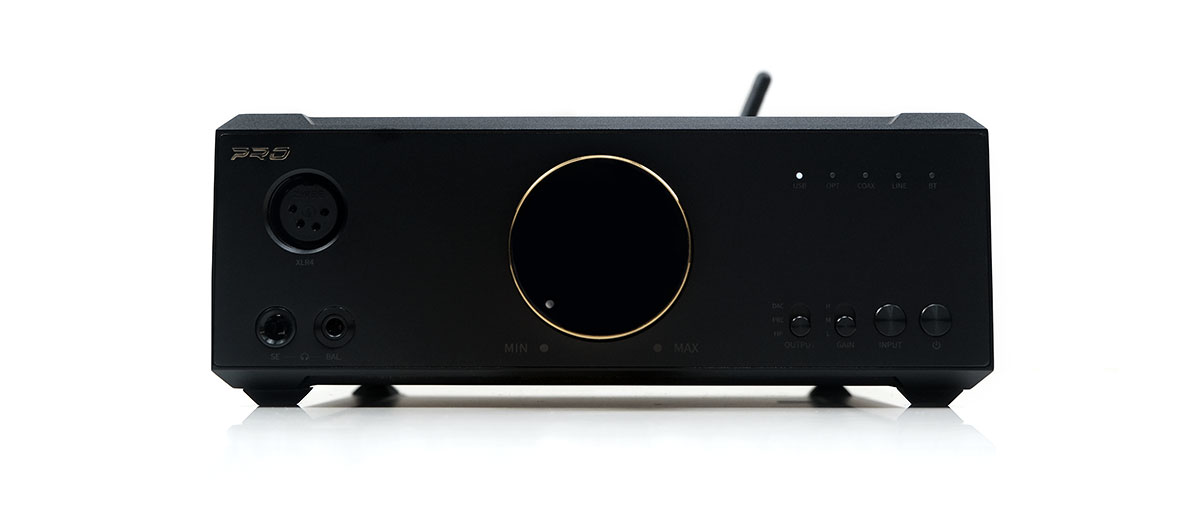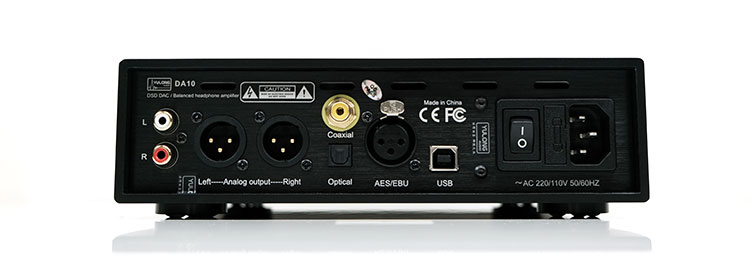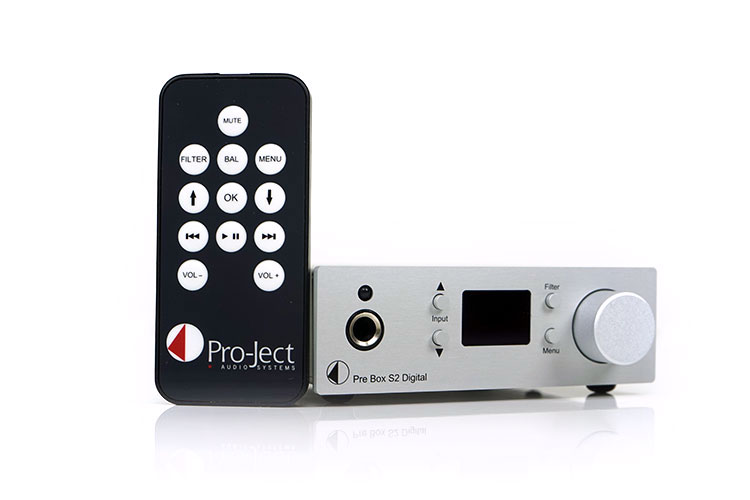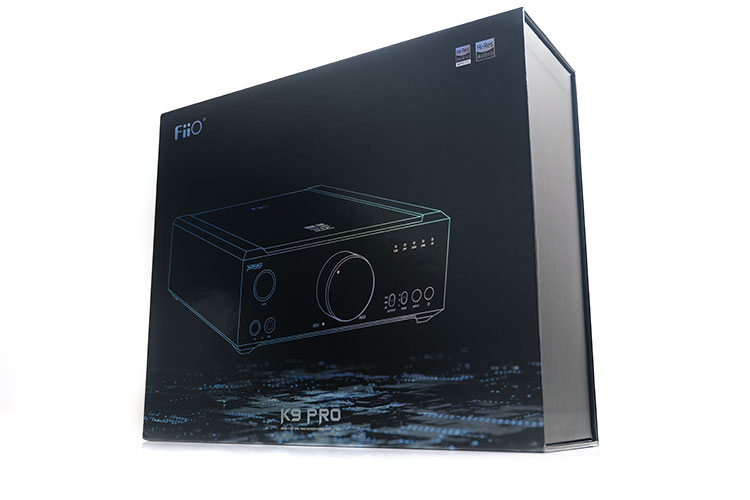Select Comparisons
YULONG DA10
$1200
The DA10 is priced a little higher than the K9 Pro ESS but it shares the same pitch, an all-in-one DAC, a balanced and SE capable headphone amplifier, with preamp capabilities.
Technical
Like the K9 Pro ESS, the DA10 functions as a headphone amplifier, DAC, and pre-amp though there is one big functional difference in that the DA10 has no line-in capability so you cannot bypass the DAC. The K9 Pro ESS offers both dual RCA SE and a 4.4mm balanced line in capability allowing the DAC and amp to operate independently.
The DA10 is equipped with a single AK4497EQ which is a bit of a rarity these days. The K9 Pro ESS uses Dual channel ES9038PRO DAC chipsets, so technically a setup in DAC materials.
The initial stage of the digital bridge is also similar with both using an XMOS XU208 USB stage, however, for jitter control, the DA10 uses a proprietary FPGA solution called YULONG JIC, ((Jitter and Interface Control).
The JIC uses a FIFO buffer with a built-in Femtosecond Oscillator and a clock recovery PLL (phase-locked loop) implementation that corrects for any potential drift in the signal timing. FiiO uses a microcontroller combined with a dual Femtosecond Oscillator for clocking management and no FPGA.
Despite the single DAC chipset, the DA10 has a slight advantage for decoding at PCM 32Bit/768kHz and DSD512 compared to 384kHz and just DSD256 for the K9 Pro ESS.
In terms of power, once again the advantage lies with the discreet engineered Class A amp of the DA10 with a balance-capable maximum output of 3W as opposed to 2.1W from the K9 Pro ESS’s THX788+ amplifier.
Design
Despite the slightly dated aesthetics of plainer DA10, the feature-set is quite close. Both offer 3-Pin XLR and 6.35mm, though the K9 Pro ESS goes one step further with a 4.4mm PO. To the rear, you also have SE dual RCA and balanced 3-pin XLR analog outputs as well as optical, USB (Type -B), and coaxial digital inputs.
What is missing from the DA10 is the K9 Pro ESS’s wireless connectivity via BT, the MQA decoding option, as well as the 4.4mm and the dual RCA SE line in options.
Interestingly, the DA10 can take a mobile OTG digital audio signal via USB but from the same input as your regular USB-DAC set up so you cannot connect both at the same time. This is an advantage for the K9 Pro ESS which has both USB Type B and USB-C ports to hook up more than one USB source.
Because the Yulong lacks wireless connectivity you have no accompanying app and all controls are manual with a multi-functional volume dial. However, it does have an LCD screen built-in which is quite easy to read. Some might see that as an advantage, some might prefer the BT Fiio Control app and function switch methodology on the K9 Pro ESS.
Performance
The DA10 is a little less adept with sensitive IEMs. There is no issue with volume control and there is a decent amount of dB incremental ranges for micro-adjustments.
However, the background with our test IEM, the Noble Sultan, was not as quiet or as black as the K9 Pro ESS in SE mode. I did get a little bit of hiss at very low levels and a slight left channel bias also.
With less sensitive IEMs such as the Vision Ears EXT, the background noise dissipates and is replaced by a nice quiet performance and much-improved channel balancing at low volume levels. I would suggest sticking around 110dB SPL for the optimal performance from the DS10 if you plan to use easy-to-drive IEMs.
For headphones, the two units produced a fairly evenly matched performance for moderately hard-to-drive planars such as the Empyrean and the LCD-XC 2021. It is only when you start moving up to the likes of the DCA Stealth or similar 80-90dB SPL planars will that additional power from the DA10 make any sort of qualitative difference.
Coloration
Out of the PO, the K9 Pro ESS will seem the more energetic of the two amplifiers with our tested headphones. I have always found the DA10’s combination of a Class A design and that AK4497EQ to be more on the full-sounding but relaxed and sweet side.
That is to say, the Yulong DAC has a slightly forward bias in the low-end that tails off progressively through the mids and treble in terms of imaging aggression. The amp is fairly transparent by the way, something we ascertained in the original review back in 2019. This is more about the DAC itself and how Yulong has tuned it.
The K9 Pro ESS is more neutral with perhaps a little more vocal directness or focus and slightly less forgiving. Its timbre is cooler, more of that classic Class A/B push-pull solid-state sound that comes across as more revealing, more impactful, but less relaxing.
It does very well in terms of bass layering with a punchier low-end performance whereas the Yulong goes for smooth, warmer, and perhaps the more analog sounding of the two amps.
I do give a slight edge to the K9 Pro ESS’s staging performance. The DA10 isn’t quite as tall or pushed out as wide and delivers a natural but cozier staging environment rather than the more immersive and wider imaging of the K9 Pro ESS.
Pro-Ject Audio Pre Box S2 Digital
$399
Comes in a lot cheaper but, like the FiiO, the S2 Digital is also a headphone amplifier, DAC, and pre-amp or a much tinier ‘all-in-one’ for headphone enthusiasts.
Technical
Both have dual Sabre DAC chipset implementations, however, the S2 Digital uses a dual-mono ES9038Q2M with a 5V switching power supply or simply a 5V USB port as opposed to the full-channel linear power supplied ES9038PRO design inside the K9 Pro ESS.
Decoding, however, is excellent on the S2 with up to DSD512 and PCM 32BIT/768kHz as opposed to DSD256 and 384kHz on the K9 Pro ESS.
The FiiO does have that BT wireless compatibility though which the S2 does not and also it can unfold 8X for MQA as opposed to 4X on the S2. One other side note, the S2 is officially ‘Roon Tested’ though both will work similarly with Roon via USB.
It is really the amplification side where the K9 Pro ESS makes its presence felt. The S2 Digital is a single-ended topology with an ESS9602 headphone amplifier. Whereas the K9 Pro ESS uses a much more powerful fully balanced THX788+ circuitry meaning both SE and balanced input and output options.
The SE is kind of weak here with just 68mW into a 32Ω load SE compared to the massive 2.1W maximum output from the K9 Pro ESS balanced output. Even on a like-for-like basis, the SE of the FiiO unit can churn out 1.1W into the same load.
For me, the S2 Digital will be just fine with IEMs and some very easy-to-drive headphones, the K9 Pro will do much better with more demanding gear.
Design
It is really the form factor here that would dominate the initial comparative discussion. The S2 Digital is tiny as in the palm of your hand tiny and a superb fit for a tiny office space. The K9 Pro ESS is fairly compact by HiFi standards and can flip on its side with the stand but its much bigger and heavier.
Of course, bigger means more space and with more space available you do get a lot more features compared to the S2 digital. For example, you only get one PO with the S2 Digital, a single SE 6.35mm output whereas with the K9 Pro you get XLR and 4.4mm balanced as well as a 6.35mm output.
The rear panels play out in much the same way with the FiiO offering analog outputs and inputs both balanced and unbalanced and the S2 just offering a single dual RCA SE input. Digital connectivity is much closer though with both offering USB, coaxial and optical inputs.
The S2 Digital has no wireless connectivity but if you want to add a complete suite of ethernet and WiFi lossless you can stack the S2 Digital with Project Audio’s Stream Box 2 device for another $350 or the same price as the K9 Pro ESS which opens it up to a much wider lossless streaming world.
Only with the Stream Box 2 do you get any remote interface otherwise there is no FiiO Control-like app with the S2 Digital. You do get a remote control which I find very useful as the manual control interface on the S2 is very small and awkward to use compared to the user-friendly FiiO mix of hardware switches, volume dial, and app.
Performance
If you think by downsizing to a high-quality sensitive IEM would level the playing field between these two devices’ power differences then think again.
Paired with the Noble Audio Sultan, you can clearly hear the improved dynamic range and channel separation from the K9 Pro ESS. With the Meze Empyrean, the K9 Pro ESS is way ahead of the S2 in terms of driving capability.
Both deliver black backgrounds with an IEM and a headphone but it is how both scale with power and how resolving that dual channel PRO DAC is that puts the K9 Pro ESS a step above.
How to put it? It’s like hearing a clean and clear performance from the S2 and then putting a lens onto your music when switching over to the K9 Pro ESS. Everything gets magnified, sounding more vivid, holographic, and definitely a lot more resolving.
By comparison, the S2 sounds centered, less expansive with instruments bunched up a little more. Does it sound more forgiving? Yes, in a way but you are losing information in the performance as a result.
Perception is everything here so initially, you might feel there is more vocal presence with the S2, perhaps a more robust instrumental note quality in terms of note physicality and a slightly smoother tone.
In reality, the K9 Pro ESS is more extended, casting a much bigger and more dynamic soundstage so vocals have their place but in turn, you get an airier and improved treble presence and more headroom for it to make that presence felt.
You simply hear more of what is going on around you with improved high-frequency resolution and improved layering on the low-end also to enhance the perception of depth and staging size.
Shanling EM5
$849
The recently reviewed Shanling EM5 is the very definition of an all-in-one but with a slightly higher price point compared to the K9 Pro ESS. It may also appeal more to the Wireless audio enthusiast.
Technical
Both units offer a DAC, a headphone amplifier, pre-amp capability as well as BT connectivity. However, the EM5 goes further with a built-in touchscreen-capable Android OS layer, local storage, and WiFi/NAS capability. If any device wants the all-in-one title the Em5 covers the bases far more extensively.
However, compromises have been made to be able to offer so much. Instead of the K9 Pro ESS’s dual ES9038PRO 8-channel implementation, the EM5 uses an older single AK4493EQ DAC design. This is a discontinued chipset so the product sunset date might well be known in advance whereas the K9 Pro ESS lifecycle could be a lot longer.
Decoding is surprisingly similar despite the age gap of the chipsets at PCM 32BIT/384kHz as well as DSD256 natively and 8X MQA. The methodology of receiving is very different though with the K9 Pro ESS primarily wired and Bluetooth, whereas the EM5 can additionally process via RJ45 ethernet and WiFi, both of which are lossless.
For output power, the K9 Pro ESS does have an advantage here with a maximum of 2.1W under a 32Ω balanced and 1.1W on the same load unbalanced. The EM5 drops it a bit to 1.62W balanced and just 540mW unbalanced on similar loads.
For Bluetooth, both units can receive up to LDAC though the EM5’s module is BT4.2 only and I found it to have a shorter less reliable range compared to the BT5-capable external antenna in the K9 Pro ESS. However, the EM5 can transmit via BT whereas the K9 Pro ESS can only receive.
Design
Two desktop units absolutely brimming full of features and what you pick might come down to some nuanced factors. For the K9 Pro ESS, it has to be the superior DAC chipsets, the driving power, better BT signal strength, and the ability to use the DAC and amplifier completely independently.
I have to say though the EM5 is more discreet and more HiFi looking aesthetically speaking. The embedded Android touchscreen and glass panel on top is an elegant touch. The K9 PRO ESS is taller, stubbier, and much more aggressive-looking.
I/O is quite similar, with both offering a 4.4mm, balanced XLR and 6.35mm PO, as well as analog 3-pin XLR balanced and SE dual RCA outputs. However, for digital, the EM5 has a broader range of choices with RJ45 ethernet, optical and coaxial outputs.
The K9 Pro ESS has no digital outputs, only digital inputs, and no ethernet connectivity. However, it can accept analog inputs both balanced, (4.4mm) and unbalanced, (dual RCA) whereas the EM5 amp is very much tied to the internal DAC.
Both devices can offer OTG digital with the K9 Pro ESS using a USB-C input on the right panel and the EM5 using a USB Type-A socket on the rear panel. Mind you, with the microSD card on the left panel and onboard storage, the EM5 has little need for OTG digital unless planned for.
Performance
Both amp stages have good control for background noise, hiss, and volume adjustments with sensitive IEMs such as the Sultan or the Andromeda 2020. You do need both of them to be in low gain to maximize that control as well as ensure the channel balance is optimal at moderate listening levels.
For headphones, there isn’t a huge difference in high gain or turbo mode with the EM5 with both displaying very good levels of dynamic range gong balanced with the Meze Empyrean.
Where you will find more substantive differences is in the technical performance and coloration. The K9 Pro ESS sounds more linear, more revealing also but cooler in the timbre whereas the EM5 has a more joyful approach with a bit more warmth and punch in the bass, and a forward fuller vocal performance.
If you need a more ‘musical’ approach for your music and want more bass and vocal emphasis then the EM5 will be a better match. Certainly, bass-heavy monitors and headphones deliver a vibrant performance.
What the EM5 lacks though is similar levels of resolution and micro-detail. The K9 Pro ESS’s dual Sabre DAC does better in terms of staging expansiveness, imaging precision, and bass layering. The net result is a more holographic soundstage with excellent channel separation and imaging that stays largely neutral to slightly north of neutral in the treble presence.
One more thing to note is the dissonance over the upper mids of the EM5 which gives it a bit more of a sibilant overtone on high pitching vocals and percussion strikes. Despite the K9 Pro ESS offering a somewhat cleaner sound overall, it controls natural vocal sibilance better for me.
Our Verdict
If the M17 was out of your budget then the FiiO K9 Pro ESS is the more affordable and wiser choice for headphone users. You get a very similar coloration and presentation style for one-third of the price.
It can sound big and bold, exciting, and very much the poster-boy for what a good quality solid-state amplifier can sound like. Yet, at the same time, the K9 Pro ESS has enough nuanced control and delicacy to work very nicely indeed with sensitive IEMs.
Tonal matching is a consideration with the K9 Pro ESS. This THX788+ and ES9038PRO combination is not the most forgiving for bright headphones and monitors but it does compensate with some gorgeous dynamics and a very low noise floor.
It is also compact and modern enough to sit discreetly in your office corner and with BT connectivity thrown into what is an impressive lineup of I/O the K9 Pro ESS should prove to be a durable and relatively future-proofed amp/DAC for the next few years. Honestly, this is a very smart buy that won’t cost the earth.
FiiO K9 Pro ESS Specifications
- Power supply: AC+Built-in linear power supply
- Digital inputs: USB/Coaxial/Optical/Bluetooth
- Analog Input: RCA/4.4mm Balanced
- USB B and USB C connectors
- Headphone outputs: 4-pin XLR/4.4mm Balances, 6.35mm single-ended
- Line-out: RCA/XLR
- Seven Digital Filters
- PCM Decoding: Up to 32-Bit/384kHz
- DSD256 native decoding
- Audio clock: High-precision PLL+Dual crystal oscillators
- Output power(SE): 2.1W(16Ω), 281mW(300Ω)
- Output power(Bal): 2.1W(32Ω), 1.1W(300Ω)
- THD+N: ≤0.00025%
- SNR: ≥129dB
- Line level: Up to 5.8Vrms.







